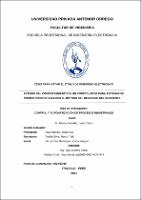Estudio del comportamiento de un controlador para sistemas de primer orden utilizando el método del descenso del gradiente

Ver/
Descargar
(application/pdf: 1.753Mb)
(application/pdf: 1.753Mb)
Fecha
2022Autor(es)
Rivera Bardález, Juan Carlos
Metadatos
Mostrar el registro completo del ítemResumen
El presente trabajo describe el comportamiento de un controlador PI usando
el método del descenso del gradiente.
En el capítulo uno se indica el objetivo del estudio que es el de Describir el
comportamiento de un controlador adaptativo que utiliza el método del descenso
del gradiente en sistemas de primer orden.
En el capítulo dos se desarrolla el primer objetivo de la investigación el cual
describe el método del descenso del gradiente para la minimización del error, en
el capítulo tres se desarrollan los tres últimos objetivos de esta investigación, se
determinan las ecuaciones que permiten el cálculo de las constantes 𝐾𝑝 𝑦 𝐾𝑖 para
la minimización del error, además se implementa el programa realizado en
Protón en un controlador 16F877 , se toman los datos para polos que se
encuentran en 𝑠 = −1, −43, −10 𝑦 − 20 con diferentes tiempos de Muestreo
siendo el mínimo 3ms.En el capítulo cuatro se realiza el análisis de los datos tomados anteriormente
indicando una dependencia del tiempo de establecimiento con el tiempo de
muestreo. The present work describes the behavior of a PI controller using the gradient
descent method.
In chapter one the objective of the study is indicated, which is to describe the
behavior of an adaptive controller that uses the gradient descent method in first order systems.
In chapter two the first objective of the investigation is developed which describes
the method of the descent of the gradient for the minimization of the error, in
chapter three the last three objectives of this investigation are developed, the
equations that allow the calculation of the constants 𝐾𝑝 and 𝐾𝑖
for the minimization
of the error, in addition the program carried out in Proton is implemented in a
16F877 controller, the data is taken for poles found at 𝑠 = −1, −43, −10 𝑎𝑛𝑑 − 20
with different sampling times being the minimum 3ms.
In chapter four the analysis of the data taken previously is carried out, indicating
a dependence of the establishment time with the sampling time.
In chapter five the conclusions of the present work are indicated.
Palabras clave
Colecciones
- Ingeniería Electrónica [147]

